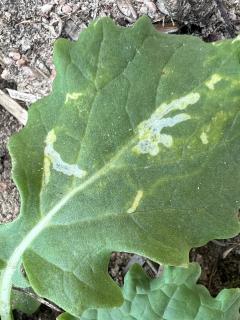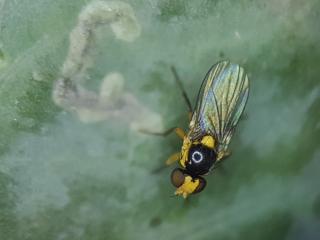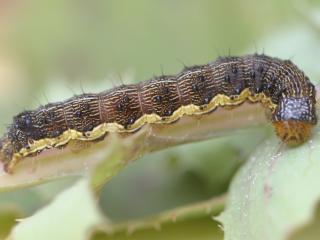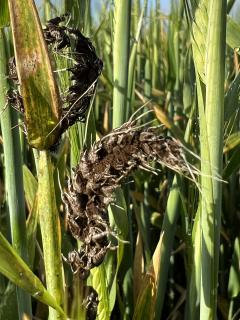Spring control of redlegged earth mites
Spring has sprung. Growers and consultants are reminded to monitor for redlegged earth mites (RLEM) in pastures and to find out their specific Timerite® spring spray date, if spraying is necessary.
The timing of the sprays is based on a short window of the season when RLEM have stopped laying winter eggs (eggs that must hatch this season) and before female RLEM start producing diapause eggs (over-summering eggs able to survive until next autumn).
Controlling mites at this time means that the whole population can be reduced, leaving few mites to carry-over to the following autumn.
Growers can obtain the spray date specific to their locality free of charge from the Australian Wool Innovation (AWI) Limited website. Growers can type the latitude and longitude of their property into the AWI Timerite® page to obtain their spray date and other useful information. Alternatively, contact the AWI Helpline on 1800 070 099.
Please note that the Timerite® date does not work against blue oat mite nor lucerne flea.
Studies by CSIRO have shown that spraying up to two weeks earlier or on the optimum spray date provides effective control of RLEM, however if spraying is delayed by two weeks after the optimum date, the carry-over RLEM population into next autumn is much higher.
Farmers intending to spray paddocks should make the most of suitable weather conditions to spray early or on time, rather than later than the predicted Timerite® date.
Growers are advised to spray only if they need to, and to rotate chemical groups to stop resistance developing in RLEM. Repeated use of synthetic pyrethroid insecticides or organophosphate insecticides (such as omethoate and chlorpyrifos) provides strong selection pressure for RLEM to develop resistance.
For more information on applying integrated pest management strategies to manage RLEM, refer to GRDC’s resistance management strategy for the redlegged earth mite in Australian grains and pastures factsheet.
If RLEM are found surviving after registered rates of insecticide treatments have been applied, please arrange for resistance testing to be conducted. Contact DPIRD entomologist Svetlana Micic in Albany on +61 (0)8 9892 8591 or 0427 772 051. This free-of-charge service is made possible with investment by the Grains Research and Development Corporation (GRDC), and is led by The University of Melbourne in collaboration with DPIRD and Cesar Australia.
Grazing reduces mite carryover in pastures
The level of grazing and quantity of pasture feed on offer (FOO) is directly related to the numbers of RLEM. DPIRD grazing trials have shown intensive grazing in spring will suppress RLEM for the following season. However, it should only be used when the population of mites is above 5000 per square metre and FOO is more than 3 t dry matter per hectare (DM/ha). To reduce RLEM, the pasture needs to be grazed to a FOO of 2 t DM/ha or less for four weeks around the TIMERITE® period to achieve a significant reduction in mites the following season. For more information, refer to DPIRD’s controlling redlegged earth mites using intensive spring grazing.
Insecticide management
Spraying of pastures in spring will have little or no benefit where pasture FOO levels are kept low (that is, less than 2 t DM/ha) by grazing. Insecticides applied to control RLEM in spring pastures or legume break crops with FOO levels greater than 3 t DM/ha will reduce their numbers. It will also provide benefits by allowing increased spring growth, seed set and a reduced potential for RLEM carry over into next autumn.
However, increased production benefits can be wasted unless the increased feed is utilised by strategic grazing management or fodder conservation. It is recommended that farmers should not spray all pasture paddocks. Instead they should select paddocks for spring spraying based on FOO levels, future grazing feed management, level of required seed production and intended paddock use next autumn.
For more information on RLEM, refer to the department’s diagnosing redlegged earth mite page.
For more information contact Research Scientist Svetlana Micic in Albany on +61 (0)8 9892 8591 or Technical Officer Alan Lord in South Perth on +61 (0)8 9368 3758.
Article authors: Cindy Webster (DPIRD Narrogin), Dusty Severtson (DPIRD Northam) and Alan Lord (DPIRD South Perth).
Cabbage leafminer
- Nalyerlup
Jack Batchelor (Nutrien Ag Solutions) recently found cabbage leafminers (Liriomyza brassicae) in a canola crop near Nalyerlup. There were only found in a small patch of the crop.
The cabbage leafminer, also commonly known as the Serpentine leafminer, is endemic to Australia.
Leafminer species are difficult to distinguish, and samples from this crop were sent to DPIRD’s Diagnostic Laboratory Services (DDLS) for molecular testing to identify the species.
The cabbage leafminer can damage canola crops.
Description
Adult cabbage leafminers are a small black and yellow fly which are 1.3 to 1.6 mm in length. Their wings are a shiny black and their head is mostly yellow. Males and females are very similar in appearance. Females puncture the surface of the leaves with their ovipositors (the tubes used for egg laying) and either lay an egg at the wounded site or feed on the juices released.
Adult flies spread throughout the crop by flight. Long distance movement of this species occurs when plant material containing larvae is transported between areas.

The larvae are legless maggots that reach up to 3 mm in length and are cream-yellowish in colour. They damage canola by feeding internally on leaves and stems creating a tunnel or ‘mine’. This leaf tunnelling is the most obvious symptom that leafminers are present.
The cabbage leafminer’s life cycle is 3 to 4 weeks at 30°C.
The American Serpentine leafminer (Liriomyza trifolii) is a closely related species, and in 2021 it was detected in WA for the first time. For more information, refer to DPIRD’s 2022 PestFacts WA Issue 12 article American Serpentine leafminer detected in WA. Should grain growers be concerned? and biosecurity alert: American Serpentine leafminer page.
Management
Cabbage leafminer is a very minor pest of canola in WA.
There are many wasp parasitoids that are natural enemies of cabbage leafminer and these parasitoids attack eggs, larvae and pupae.
Control should only be considered if the crop is not outgrowing the damage.
If insecticides are required, avoid those with broad-spectrum activity such as synthetic pyrethroids or organophosphates. Not only will they destroy natural enemies, but they are likely to result in resistant leafminer populations.
Practice good on-farm biosecurity. Localised spread of the pest is most likely to occur on contaminated plant material or equipment.
What should you do if you find a leafminer?
Growers and gardeners are encouraged to monitor plants and to report any tunnelling leaf damage and suspect flies to DPIRD. The department can help correctly identify leafminer species and indicate the absence and/or presence of the exotic American serpentine leafminer.
Growers can report leafminer observations via DPIRD’s PestFacts WA reporter app, Pest and Disease Information Service or MyPestGuide Reporter app.
Further information
For more information on leafminers contact Research scientists Svetlana Micic in Albany on +61 (0)8 9892 8591 or Jeff Russell in Northam on +61(0)8 9690 2229.
Article authors: Cindy Webster (DPIRD Narrogin) and Svetlana Micic (DPIRD Albany).
Monitor for slugs now to prepare for next season
Growers and consultants in the south coastal areas of WA are urged to monitor paddocks for slugs this spring. Assessing slug numbers and distribution in paddocks at this time of year will prepare growers for slug management next year.
The two main slug species present in WA are reticulated slugs and black-keeled slugs. For more information on diagnosing these slugs visit DPIRD’s identification and control of pest slugs and snails for broadacre crops in WA page.
Tips for monitoring for slugs
Growers are advised to focus on paddocks with a history of slug activity, which were not baited earlier in the season. Additionally, it’s important to look in adjacent paddocks, especially those that have heavier soil.
Reticulated slugs aestivate over summer under surface refuges such as rocks, in dead stalks and in soil cracks. Conversely, black-keeled slugs will actively burrow underground, meaning that they can be found in sandier soils in high rainfall areas. Both species of slugs survive hot summers by seeking moist refuges and will persist in paddocks where burning has occurred.
In spring, growers should survey paddocks to determine the areas where slugs are most likely to pose a risk at crop establishment. This will help you strategically apply baits in the following year. The best time to find slugs actively moving is nine hours after sunset, when temperatures are 7°C or above and humidity surpasses 90%. Slugs can be found during the day by looking under stubble and rocks.
During spring, if you find small slugs in the crop canopy on a wet day feeding on the flag leaf, this is a good indicator slugs are likely to cause problems next autumn.
You can also monitor for slugs by placing refuges (such as carpet mat, wet hessian sacks, tiles or plastic drums half full of water) out in paddocks and checking them the following morning. As slugs often have a patchy distribution, it is important to use multiple refuges. Fifty monitoring refuges are recommended for each 40 hectares paddock size due to their variability in Australian conditions.
Another strategy is laying bait lines before sowing in paddocks across patches identified by spring monitoring. Inspect these areas for any dead slugs the following day.
Slug management
Spring baiting has not been successful in reducing next seasons slug numbers, however further research is investigating options to reduce slug populations in the spring.
Monitoring during spring provides an understanding of the success of any management practices in autumn 2023. If you do detect slugs in your maturing crops, take note of the paddock, as this is where they will be in 2024. This will allow the ordering of baits, selection of crops and the implementation of cultural controls prior to sowing crops next year. By identifying your slug risk for next season’s establishing crops, you can plan to bait next autumn after sowing to protect emerging crops.
Best practice management of slugs requires an integrated approach.
GRDC is providing a hands-on slug management workshop on Monday 4 September at Qualeup. It is being delivered by Dr Michael Nash. For more information on this workshop, visit the event webpage.
Further information
To read about previous slug and snail activity this season, refer to the 2023 PestFacts WA articles:
- Issue 4 Growers may need to reapply baits for slugs and snails
- Issue 2 Slugs and snails have started to lay eggs
- Issue 1 Now is the time to bait snails.
For more information on slugs visit:
- DPIRD’s Identification and control of pest slugs and snails for broadacre crops in WA page
- GRDC’s Slug control fact sheet: Successful crop protection from slugs
- GRDC’s Slugs in crop: The back pocket guide.
For more information contact Research scientist Svetlana Micic in Albany on +61 (0)8 9892 8591.
Article authors: Svetlana Micic (DPIRD Albany) and Dr Michael Nash (Consultant).
Native budworm update
- Yallabatharra
- Nolba
- Marrah
- Moresby
- Moonyoonooka
- Wicherina
- Yandanooka
- Mingenew
- Carnamah
- Coorow
Peter Norris (Synergy Consulting) reports finding 10 budworm caterpillars (5 to10 mm) per 10 sweeps in a canola crop near Yandanooka. Peter also found one budworm per 10 sweeps in canola crops near Moresby and Moonyoonooka. Peter commented that budworm caterpillars are in most canola crops in the area now. This is not unexpected, given the high number of budworm moths captured in the general area earlier in the season.
Geoff Fosbury (ConsultAg) reports finding budworm caterpillars in canola crops in the Mingenew, Carnamah and Coorow regions. They are approximately 1.5 cm long and in many crops averaged about 8 per 10 sweeps. Geoff has also caught 5 to 10 budworm caterpillars per 10 sweeps in lupin crops in these areas.
DPIRD’s native budworm trapping program has also collected the following reports of native budworm caterpillars over the last fortnight. The average counts per 10 sweeps were as follows: 22 in Moonyoonooka, 25 in Wicherina, 11 in Marrah, 47 in Nolba and 123 in Yallabatharra.
Budworm caterpillars should now be large enough to find with a sweepnet in susceptible crops in other locations where moths were captured around three weeks ago.
Field pea, chickpea, lentil and faba bean crops are very susceptible to all sizes of caterpillars during the formation and development of pods. Tiny caterpillars can enter developing pods and damage seed or devour the entire contents of the pod.
Narrow-leafed lupin pods and seeds are not usually damaged by native budworm until they are close to maturity and the pods are losing their green colouration, although there has been one report this year of budworm caterpillars damaging young lupin pods.
Canola is similar to narrow-leafed lupin in that pods only become attractive to caterpillars as the crop nears maturity and begins to hay-off. Caterpillars of all sizes will enter pods at this stage, with larger caterpillars doing the most damage.
Moth trapping update
- Usual trapping locations
DPIRD’s native budworm moth trapping surveillance program has had relatively low moth numbers reported in most areas this week. The higher captures reported this week include Bindi Bindi (76 moths), Kellerberrin North (70), Grass Patch West (32), Dowerin (12), Maya (11), Cunderdin (7), Cuballing (6) and Southern Cross (5). Some of these areas have reported higher numbers in previous weeks.
The following trap sites have recorded the following number of moths in the past fortnight: Yallabatharra (71 moths), Moonyoonooka (48), Wicherina (56) and Nolba (8).
A mapped view of all recent native budworm trap captures is available at Cesar Australia’s MothTrapVisWA page. Viewers need to select the desired trapping date range.
More results of this week's trappings are available for viewing at the department’s native budworm moth numbers 2023 page.
Pesticide options for the control of native budworm can be found in DPIRD’s 2023 Winter Spring Insecticide Guide.
Detailed information on this pest can be found at the department’s management and economic thresholds for native budworm.
For more information, contact Technical Officer Alan Lord in South Perth on +61 (08) 9368 3758 or +61 409 689 468.
Article author: Alan Lord (DPIRD South Perth).
Barley loose smut – this year and going forward
Loose smut is more prevalent in WA barley crops this year primarily due to the conducive spring conditions experienced in 2022. When last years crop was heading during spring, the few infected heads present had an excellent opportunity to spread infection to developing grain. After growing out grain this year, a noticeable rise in the number of plants exhibiting infected heads compared to the past few years has become evident, particularly in the susceptible Hindmarsh family of varieties.
Since loose smut stands out in crops, it is easy to overestimate the actual level of infection present. However, if there are mild conditions during flowering this year, there are likely to be more than enough smut spores around to continue the cycle of infection. Therefore, growers are advised to treat seed for next season with registered fungicide seed dressing to prevent it producing smutted heads in 2024.
Seed treatment
While growers may feel disappointed when their crops get infected with loose smut after applying a seed dressing that is registered for smuts, the effectiveness of seed treatments relies on precise application. Even under optimal conditions, smut still has the edge. For example, in a scenario where a 10 x 10 m square of crop contains 10 to 12,000 plants, even if the seed control rate is as high as 95% and the initial seed infection is only 0.5%, this will still result in an average of three infected plants evading control in that 10 x 10 m area.
The barley variety Maximus CL has a pedigree of Scope, Fathom and La Trobe. This suggests that the La Trobe heritage might be prone to loose smut infection. However, DPIRD does not have trial data directly comparing it to other varieties yet.
DPIRD trials conducted in 2018 revealed that SDHI seed dressings, such as Vitaflo, Vibrance and EverGol Energy, all provide excellent control greater than 95% while other registered products tested are still effective (>60% control), but not quite as good (see Table 1). It is important to note that in these trials the seed dressing products EverGol Energy and Rancona Dimension were tested at the lowest rate registered for loose smut at the time.
| Seed dressing | Rate (L/t seed) | Infection reduction (%) | |||
|---|---|---|---|---|---|
| Gibson | Katanning | Wongan Hills | All sites | ||
| Untreated | 0 | 0 | 0 | 0 | 0 a |
| Baytan T | 1 | 69 | 67 | 67 | 67 c |
| EverGol Energy | 1.3 | 100 | 99 | 100 | 99 e |
| Rancona Dimension | 0.8 | 55 | 60 | 64 | 60 b |
| Raxil T | 1 | 70 | 79 | 74 | 74 d |
| Vibrance | 1.8 | 95 | 96 | 98 | 96 e |
| Vitaflo | 2.5 | 99 | 99 | 91 | 96 e |
| Average | - | 73 | 74 | 74 | 74 |
For more fungicide information refer to DPIRD’s seed dressing and in-furrow fungicides for cereals in WA page.
Further information on loose smut
To read about earlier loose smut activity this season refer to the 2023 PestFacts WA Issue 12 article loose smut in barley.
For more information on barley loose smut, refer to the department's webpages:
- Diagnosing barley loose smut.
- Controlling barley loose smut.
- Smut and bunt diseases of cereal - biology, identification and management.
For more information, contact Plant pathologists Andrea Hills in Esperance on +61 (0)8 9083 1144, Kithsiri Jayasena in Albany on +61 (0)8 9892 8477, Geoff Thomas in South Perth on +61 (0)8 9368 3262, Ciara Beard in Geraldton on +61 (0)8 9956 8504 or Kylie Chambers in Northam on +61 (0)8 9690 2151.
Article author: Andrea Hills (DPIRD Esperance).
Article input: Kithsiri Jayasena (DPIRD Albany) and Geoff Thomas (DPIRD South Perth).




